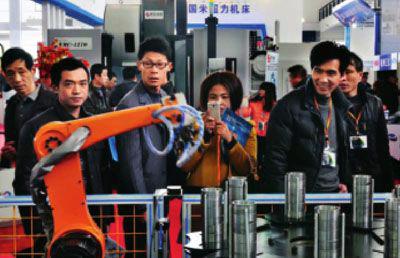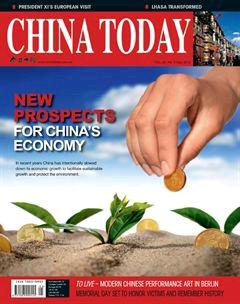The Path to Reaching Economic Growth Targets
By+LIN+YIFU
IN 2013 Chinas new leadership steered the country onto a fast and stable development track in accordance with the peoples expectations. Aiming for an economic growth rate of about 7.5 percent for 2014 is both achievable and necessary. To reach this goal against the backdrop of a sluggish global economy, China needs to rely on domestic demand, which in large part arises through investment. To spur investment by local governments, the issue of financing platforms should be fundamentally addressed. From a longterm perspective, local governments should be allowed to issue bonds. Further, to promote investment in the field of industrial modernization, more financial support and better governmental coordination are needed.
Good Performance Achieved?with?Difficulty
Premier Li Keqiang stated in the 2014 government work report that last year Chinas gross domestic product (GDP) increased by 7.7 percent year-on-year. The consumer price index (CPI), meanwhile, rose 2.6 percent, registered urban unemployment stood at 4.1 percent, and 13.1 million urban jobs were created.
This good performance came with difficulty, especially considering adverse factors. Over the past two years, the world economy has remained inert. Europe, as Chinas largest export market, saw negative economic growth of 0.6 percent in 2012 and of 0.4 percent in 2013. The U.S. economy, the second largest market for Chinese exports, grew by 2.7 percent in 2012 and 1.8 percent in 2013. Japan, as the worlds third largest economy, grew by 1.9 percent in 2012, and 1.7 percent in 2013.
Exports are one of the top three driving forces for economic growth. However, with the worlds three major markets in a slump, exports and economic growth have been dampened in emerging economies. Last year Brazil and India grew by only 2.2 percent and 4.9 percent respectively, well below Chinas growth.
Under such external pressure, Chinas economic growth slowed to 7.7 percent in the first quarter of 2013, and dipped further to 7.5 percent in the second quarter, reigniting fears that a crisis was coming Chinas way. The Chinese government took measures to rein in incremental production capacity while tap-ping the potential of existing capacity, and advanced economic restructing and reforms, driving economic growth back up to 7.8 percent in the third quarter and 7.7 percent in the fourth quarter. In this way, China maintained a respectable 7.7 percent growth for the whole year. As Premier Li stated in his work report, “In the last year, we met more difficulties but delivered better performance than expected.”
Domestic Demand
Looking at the prospects of Chinas economic development in 2014, a multitude of challenges and difficulties are still in view. Although developed countries have shown signs of recovery, the foundation of this recovery is still fragile.
The World Bank expects the U.S. economy to rise by 2.8 percent this year, from 1.8 percent in 2013. This may appear encouraging, but in the past, after every financial crisis U.S. economic growth always rebounded robustly, often up to seven or eight percent. However, five years after the outbreak of the last financial crisis, the U.S. still has not shown signs of a rebound. Statistically, the U.S. unemployment rate has dropped to 6.7 percent, on a par with that of 2008. Importantly, the U.S. unemployment statistics ignore the number of unemployed people who have not actively sought employment for at least one month. This part of the population is regarded as having quit the labor market and are therefore not counted as “unemployed.” The statistical indicator that would more accurately reflect the countrys employment situation should be the labor participation rate of the working population of working age. If this factor were taken into account, the U.S. unemployment rate would exceed 10 percent.
The employment situation in Europe is even more grim. Unemployment in countries such as Greece and Spain has soared to 26 percent, with that for college graduates above 50 percent.
As for Japan, World Bank predictions forecast a downturn, with a growth of only 1.4 percent.
Chinas exports will continue to face immense sustained pressure in 2014. Chinas export growth target was 8 percent in 2013, and 7.5 percent this year. Since its reform and opening-up, Chinas exports have enjoyed an annual average growth of over 16 percent. Even if the 2014 export target is reached, it would only reach half of past average levels. Moreover, the growth target will only be met if tremendous efforts are made. Therefore, given the gloomy world economic situation, to achieve its 2014 target of 7.5 percent growth in GDP, China can only rely on domestic demand.
7.5 Percent, Indispensible and Achievable
Why does China have to maintain a relatively high growth rate? This can be ascribed to the following four reasons. First, a relatively high growth rate can create more jobs. The yearly employment demands of its growing labor force keep increasing in China, and this year 10 million new urban jobs will be needed, which can only be met with economic growth. Second, the problem of excess production capacity persists in China. If the economic growth rate drops sharply, this problem will deteriorate, curtailing investment opportunities, aggravating downward pressure, and thereby trapping the Chinese economy in a vicious cycle. Third, a reasonable growth rate could help China avoid debt risks. If the economy shows a drastic downturn, the loan usage rate of existing projects will be lowered, thereby also lowering the rate of return and heightening debt risks. Finally, the government also needs healthy growth to bring in sufficient revenues. If the growth rate is too low, government finances will face stringent restrictions.
Chinas economic growth target is not only achievable, but also creates opportunities for higher growth quality and efficiency. Domestic and overseas scholars agree that achieving this target requires a reliance on domestic demand, but continue to disagree over whether this demand will come from investment or consumption.
With a faltering world economy, if China seeks to achieve quality economic growth by relying on domestic consumption, it has to ensure constant increases in peoples incomes. If this condition is not met, increasing consumption would only lead to a spike in debt, which could trigger a crisis. This is true for both individual households and countries. To achieve a sustainable increase in household income, labor productivity has to be raised; and higher labor productivity can only be achieved through technical innovation, industrial upgrades and infrastructural improvement, all of which require more investment.
To transform its economic growth from the old export-driven mode to one led by domestic demand, China has to rely on investment. In the short term, investment will increase demand and employment, which could drive up the economic growth rate. Good investment will raise labor productivity in the long run and allow peoples incomes to enjoy sustainable increases, giving them the means to buy and invest. Sustainable economic growth could then be realized without negative aftereffects.
Two questions then emerge: Are there good investment opportunities in China? And, are sufficient investment resources available? The answers to both are favorable. As a middle-income country, China has immense space for industrial upgrading, which could bring about a spate of investment opportunities. For example, the improvements in urban infrastructure, like subways and various pipelines and networks, require high investment, Meanwhile, livelihood projects, affordable housing projects and environment management projects all feature high social and economic returns.
Chinas investment resources are highly abundant. Last year, the aggregate volume of Chinas central and local government debt accounted for 39.4 percent of its GDP – quite a low level compared to the rest of the world. Chinas personal savings rate is approaching 50 percent, and its foreign-exchange reserve stands at US $4 trillion. If China could make good use of these available investment resources, it would achieve healthy and quality economic development.
Local Financing Platforms
Funding for infrastructure, livelihood projects and environmental protection mostly comes from local governments. When local governments make such investments, they are not allowed to issue bonds, which leads to the establishment of various financing platforms. Most investments made by local governments are long term, while loans from these financing platforms are short term, giving rise to problems engendered by this maturity mismatch.
In the past, local governmental financing platforms mainly obtained loans from banks. However, nowadays, in order to control risk, banks have decreased loans to local financing platforms, which consequently have prompted such platforms to resort to shadow banking. Shadow banks lend at high interest rates and lack supervision, which leads to heavier burdens on local governments and exposes them to greater financial risks. Although infrastructure projects, livelihood projects and environmental protection projects initiated by local governments feature a high social return rate, the rate of their economic return is usually around three percent, according to some research; in contrast, the loan interest rate of shadow banks may be as high as seven to eight percent.
How could this problem be solved? In the long run, laws should be amended to allow local governments to issue bonds. In the short term, as the 2014 government report mentions, the central government could first issue debt securities on behalf of local governments. This year, China plans to sell RMB 400 billion worth of government bonds, and the volume could be raised to RMB 1 trillion or more if necessary. Meanwhile, local governmental financing platforms should be given better access to regular banks for loans, since these institutions demand a lower interest rate and are better regulated than shadow banks.
Industrial Upgrading
As already cited, industrial upgrading will bring about many investment opportunities. Nevertheless, to accomplish industrial upgrading, two conditions are required.
First, industrial upgrading requires better financial support. The Third Plenary Session of the 18th CPC Central Committee has put financial reform on the government agenda, deciding to let the market determine interest rates, and to build a multi-level capital market. This reform orientation must be provided with supporting measures, otherwise the results could fall short of expectations. The current reform of interest-rate liberalization, aimed to stimulate flow of funds to productive and well-managed enterprises, is making brisk headway. However, during this reform, some regional governments have taken loans from shadow banks rather than regular banks, because, with soft budget constraints, they are generally insensitive to high interest rates. In this circumstance more capital flows to local financing platforms than to enterprises. The best solution is to al-low local governments to issue bonds, which have lower risk and interest rates than corporate bonds. With both local government bonds and corporate bonds available in the market, investors can make selections based on their own risk tolerance and expected returns on investment. Currently, local financing platform debts, with lower risks and higher interest rates, have stymied the development of corporate bonds.
To promote interest-rate liberalization, the financial structure should also be improved. It is necessary to develop small and medium-sized regional banks to provide better financing services to the majority of farmers and micro, small and medium-sized businesses. At present, setting up small and medium-sized regional banks requires having existing commercial banks as the strategic investor – an unreasonable rule which should be abolished. Another decision made by the Central Committee should be implemented: to allow qualified private capital to establish small and medium-sized regional banks.
Secondly, industrial upgrading needs government coordination and support. Industrial upgrading needs to seek out new industries with comparative advantages, during which the problem of information asymmetry arises. If the first enterprise to invest in a new industry fails, it has to assume all the losses, yet if it succeeds, other enterprises follow on rapidly, so reducing the profit margin. As a result, smart entrepreneurs are often unwilling to be the guinea pig. It should be also noted that many elements for industrial upgrading are out of the control of individual enterprises. For example, new industries often need industrial clusters to solve logistics problems, while the formation of industrial clusters requires the presence of a large number of enterprises in an area. This is impossible without coordination. Furthermore, new industries call for new technicians, skilled workers and infrastructure, which also depend on the government. In the field of industrial upgrading, as mentioned in the government work report by Premier Li Keqiang, it is necessary to give full rein to both the invisible hand of the market and the visible hand of the government.
Although the external environment in 2013 was intricate and complex, the new Chinese government has weathered these tests and performed well. To look ahead in 2014, as long as we strengthen reforms I believe the GDP growth goal of 7.5 percent is within reach.
Contribution to the World Economy
As the worlds No. 2 economy and the largest goods-trading nation, China has exerted a growing influence on the world economy. With annual growth at seven to eight percent, it accounts for over one third of the worlds economic growth. On the one hand, Chinas economic growth has made a significant contribution to the world economy. On the other hand, China has to rely on a favorable global economic environment to achieve further development.
Chinas rapid economic development is not only important to itself, but also beneficial to the world. A better-off China has created a large market for developed countries, because the technologies and equipment that it has depended on are all from such countries.
Take the 2008 financial crisis as an example. Germany was the best performer in the crisis among all the developed countries. As a Nobel laureate in economics has noted, behind the German miracle is Chinas rapid development. Much of the key machinery and equipment that China needed came from Germany. High Asian demand fueled the German economy.
Moreover, Chinas rapid development also brings substantial benefits to developing countries, which possess relatively rich resources. As Chinas industry rises toward the high end of the “smiling curve,” many primary processing industries are gradually moved out. In the process, China has helped developing countries to achieve industrialization, internationalization and modernization.
In the 1960s, Japan employed 9.7 million workers in its manufacturing industry. In the 1980s, South Korea employed 2.3 million in its manufacturing industry, Taiwan nearly two million, Hong Kong one million, and Singapore about a half million. Yet currently, Chinas mainland employs 150 million in the manufacturing industry. This transfer of industries based on changing comparative advantages is called the “Flying Geese” model in international economics; however, I would like to re-label it as the “Leading Dragon” model. I believe that in the coming 10 to 20 years, Chinas labor-intensive manufacturing industry will move to foreign countries, and soon all developing countries in the world will be able to enjoy development opportunities similar to those that Japan brought to the four “Asian Tigers” in the 1960s, which in turn brought to Chinas mainland in the 1980s. In this way, we could realize the vision that Chinese President Xi Jinping described at the Boao Forum last year: A single flower does not make spring, while all flowers in full blossom bring spring in full swing.
Therefore, Chinas rapid development is a boon not only to itself, but also to developed countries, moderately developed countries, resource-rich countries and populous, low-income countries as well.
Meanwhile, the most important fact is that, alongside the rise of Chinas status, the international order has changed.Therefore, the rules of the game need to be modified and China should actively participate in international governance.

